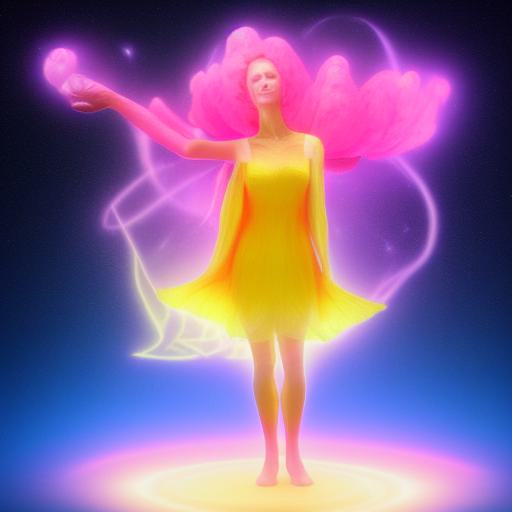How to write this prompt?
Here is a breakdown of the various elements and how they contribute to the final image generated by an AI system:
- Overall theme: The theme of the prompt is a woman floating in space, portrayed in a psychedelic style.
- Character description: The woman is described as a psychedelic elf, which sets the tone for the surreal and otherworldly nature of the image. She is also holding a pink flower, which adds a pop of color to the scene.
- Clothing description: The woman is wearing a navy blue dress, which contrasts nicely with the pink flower and adds depth to the image.
- Lighting and effects: The lighting in the image is ultra-realistic, with volumetric fog and glowing radioactive effects. This creates a sense of depth and atmosphere, making the woman appear as if she is truly floating in space.
- Style and rendering method: The artwork is described as a digital 2D psychedelic art, inspired by Martina Hoffmann’s style, and rendered with Octane Render. This combination gives the image a highly detailed and textured look, with a focus on bright colors and intricate patterns.
All of these elements work together to create a specific mood and atmosphere in the final image. By carefully crafting a prompt that includes details on the character, clothing, lighting, and rendering style, you can help an AI system generate an image that meets your specific artistic vision.
What is volumetric fog, and how does it contribute to the overall atmosphere of the image?
Volumetric fog is a technique used in computer graphics to simulate the appearance of fog or mist. It creates a three-dimensional, translucent effect that adds depth and atmosphere to the scene. In the image described in the prompt, the use of volumetric fog helps to create the impression that the woman is floating in an ethereal, otherworldly space.
Who is Martina Hoffmann, and how does her style influence the artwork generated by the AI system?
Martina Hoffmann is a contemporary artist known for her psychedelic and surreal artwork. Her style often incorporates bright colors, intricate patterns, and surreal imagery, which are all elements that can be seen in the artwork generated by the AI system described in the prompt. By using her style as inspiration, the AI system is able to create an image that is in line with the psychedelic and surreal themes of Hoffmann’s work.
How can an AI system be trained to generate highly detailed and textured digital art, like the image described in the prompt?
To generate highly detailed and textured digital art, an AI system must be trained on a large dataset of images that showcase the desired style and level of detail. This can involve using machine learning algorithms to analyze and identify patterns in the images, as well as training the AI system to generate similar images through trial and error. Additionally, using specialized rendering software like Octane Render can help to add a level of realism and texture to the final image.
How does AI generate art?
AI can generate art using a variety of techniques and approaches, including deep learning, machine learning, and computer vision. These techniques rely on complex algorithms that analyze patterns and features in existing artwork and use that data to generate new, original pieces. One approach is to use a generative adversarial network (GAN), which pits two neural networks against each other in a game-like scenario, with one network generating art and the other attempting to discern whether it was created by a human or an AI. This process can be repeated many times until the AI-generated art is indistinguishable from human-made artwork. Another approach is to use reinforcement learning, where an AI system is trained to make decisions based on a reward or penalty system, such as the aesthetic value of an image.
The process of generating art using AI can vary depending on the specific method and algorithm used. Some systems generate art from scratch, while others use pre-existing images as a basis for creating new artwork. In many cases, the AI system will also incorporate feedback and input from human users, allowing for a more collaborative approach to art creation.
What types of art can be generated using AI?
AI can generate a wide variety of art styles and types, including digital paintings, abstract art, photorealistic landscapes, and even music and poetry. One of the benefits of using AI to generate art is that it can create pieces that are truly unique and original, as the algorithms and techniques used can produce outcomes that are difficult for humans to replicate. AI-generated art can also incorporate a range of techniques and styles, such as surrealism, impressionism, and cubism, as well as experimental and avant-garde approaches to art creation.
Some AI-generated art may also incorporate elements of machine learning and data visualization, such as using algorithms to create visualizations of complex data sets. Additionally, AI-generated art can be used in a variety of applications, such as advertising, product design, and even as a tool for therapy and mental health. Overall, the possibilities for AI-generated art are vast and diverse, and continue to expand as new techniques and algorithms are developed.
Looking to add some cutting-edge creativity to your designs? Look no further than Visual Paradigm Online! With our innovative design tools, you can seamlessly incorporate stunning AI-generated art into your graphics with just a few clicks. Our user-friendly interface and extensive range of design templates and assets make experimentation a breeze, so you can explore countless styles and layouts until you find the perfect combination for your project. Elevate your designs to the next level with Visual Paradigm Online today!


